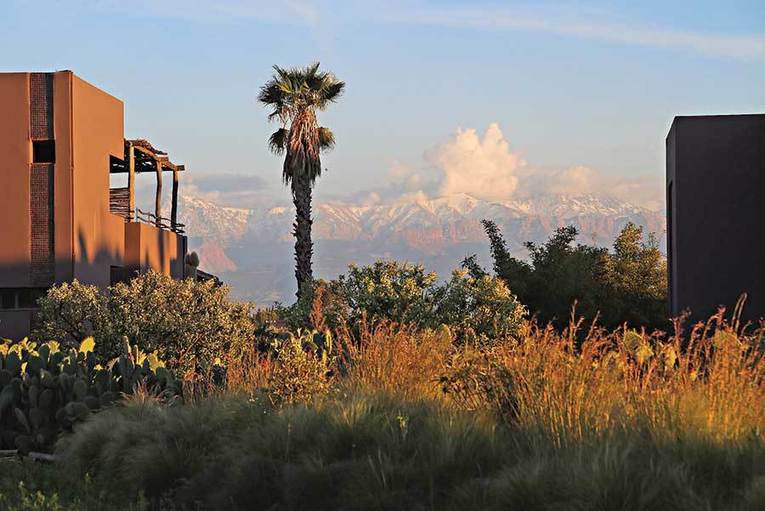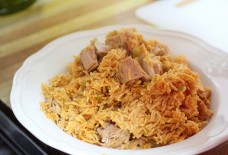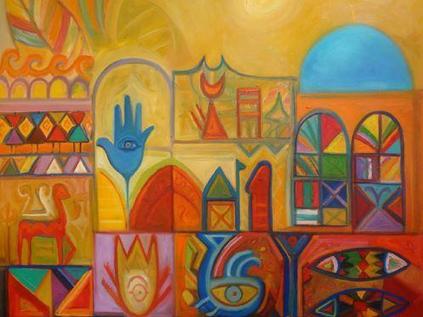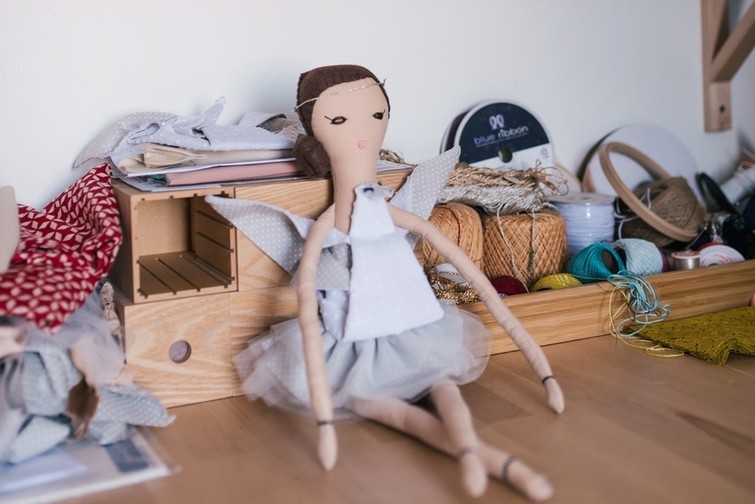
BY SARAH HART
AMERICAN THEATRE
Just over 10 miles from the teeming streets of Marrakech, a group of American and Middle Eastern/North African (MENA) artists will congregate this month under the auspices of the Sundance Institute Theatre Lab in Morocco’s Ourika Valley. This gathering is not an offshoot of the annual July lab at the Sundance Resort in Utah; this time out the Moroccan setting is the main Sundance Theatre Lab. Among other things, it’s a move that signifies a long-term initiative by Sundance to focus on artists of the MENA region.
At first glance, you could be forgiven for thinking this change isn’t so sweeping. The nonprofit arts center Dar al-Ma’Mûn is housed in the strikingly beautiful Fellah Hotel, an upscale desert resort—albeit one that touts donkey-grooming and goat-milking alongside fine dining and yoga among its luxury amenities. And funding for the nonprofit comes, in part, from a portion of each hotel guest’s fee, as well as private partners and grants—not unlike the relationship between Utah’s Sundance Resort and the Sundance Institute.
“I call it Sundance Morocco,” said Philip Himberg, artistic director of the Sundance Institute Theatre Program. “It really was the place that was most like Sundance—that mirrored Sundance values.” This sense of place—or perhaps more accurately, the sense of being away from a place—has always been at the heart of Sundance Theatre programming, whether at its primary home in Utah, at Ucross in Wyoming, or on islands in the Indian Ocean off the coast of East Africa.
But to see what sets the MENA lab apart, take a closer look at the guest list: For the first time, the annual event will consist of half American artists and half international artists. This is a departure from the model used until recently in East Africa, which, while it sustained Sundance’s focus abroad for more than a decade, generally built separate labs around African playwrights, with a combination of American and African advisors.
“It was really important to me, because we are replacing the July lab, that Americans would have the same rigorous dramaturgical opportunity to move their plays forward,” noted Himberg. “One of the measures of success will be that people did not feel they had to compromise the Sundance value, the Sundance rigor. What’s different is that there is an added responsibility to talk over the dinner table. You’re kind of ambassadors. It may be two cultures, but it’s one lab.”
Himberg and his team at Sundance—including producing director Christopher Hibma—had felt for some time that an exchange with MENA artists was needed, and had laid the groundwork with visits to the region and invitations for MENA artists to come to Utah. “We have chosen areas of the world to connect with where we have felt that there would be storytelling of a younger generation,” explained Himberg. “Usually because those were areas of the world that are going through huge shifts, socially, culturally, politically.” But Himberg called the decision to transform the lab this year as coming “from a very heartfelt place, having to do with my life, and who we all are in the theatre world, and who we are as American citizens in the world.”
He admitted that his initial thinking was to “do what we usually do, which was to have our lab in Utah, then a lab overseas. But something was uncomfortable about that. I was getting up every morning, reading The New York Times, about the horrible situation in that part of the world. Then I’d go to work and do my theatre work. It felt very siloed. We were bringing artists here, but it felt different. I asked myself, ‘What’s the scariest, most frightening thing you could do next year?’” He realized that canceling the July lab and “creating one space where American artists and Middle Eastern/North African artists work side by side, borderless, as storytellers, as world citizens, would be the most adventurous and risky and fascinating and rich idea.”
Himberg and Hibma knew they would need a partner with ties to the region, so they brought on Paris-based Syrian/Iraqi arts manager Jumana Al-Yasiri to helm the Middle Eastern/North African side of the exchange. She visited the lab in Utah in July 2015 to see how Sundance’s new-play development process resonated with that of the MENA region, and together they hashed out details, from a working definition of MENA artists (they settled on: those writing in the Arabic language), to the question of translation (finalists’ works were translated in part by Al-Yasiri and a jury of MENA readers for their American counterparts), to cultural nuances of the dramaturgical process.
“The main difference,” suggested Al-Yasiri, “is that theatre in the Arab world is director-driven. With all the work that Sundance does, it seems very clear that the playwright is the star in the production process. The theatre in the Arab world is very visual, especially in the young generation. For sure it’s linked to contemporary history—social networks and YouTube and images of war. Everybody wants to have audiovisual in their performances. Text, the written play on paper, is only the basic material to start building the play. The writing is completed, achieved during the rehearsal.”
Unsurprisingly, these differences necessitated a slightly different approach in the application process, with Al-Yasiri urging the American jury to consider the application itself, as well as additional materials, as strongly as—if not more so than—the script. “Maybe from the U.S. if the application is not so good but the play is strong, it can pass,” she explained. “On the MENA side you need to look at everything.”
Still, the tried-and-true Sundance method won’t be completely transformed in Morocco; indeed, Al-Yasiri is excited to bring more dramaturgs into the room. “We don’t have a lot of dramaturgs in the region, and I think that Sundance MENA is actually an excellent opportunity to involve dramaturgy,” she said. American dramaturgs Janice Paran and Christian Parker will be joined by Abdullah Al-Kafri from Syria and Chrystèle Khodr from Lebanon. The quartet began meeting via Skype several months ago to compare techniques.
Some projects—such as Iraqi choreographer Amar Al-Bojrad’s wordless dance piece on the nature of boredom—won’t be hampered by any lack of shared language. Others—like Marion Lécrivain’s adaptation and Zakaria Alilech’s translation of Sarah Kane’s Crave into a Moroccan dialect—have complicated linguistic needs inherent in their genesis.
Lebanese performance artist Rima Najdi specifically requested an American director for her solo piece, developed from her video and journal recordings of going about daily activities in Beirut while wearing a fake bomb strapped to her chest (director Mark Brokaw has signed on to provide the outsider’s perspective). Syrian playwright Anna Akkash originally wrote her highly poetic and elegiac Them—about five women grieving the men they’ve lost in war—in English, but it will be performed in Arabic.
U.S. projects include Hansol Jung’s Wild Goose Dreams, about an affair between a North Korean and a South Korean, both separated from their families, directed by Leigh Silverman; Patricia Ione Lloyd’s non-naturalistic portrait of an African-American family, Eve’s Song, directed by Timothy Douglas; Sam Marks’s White Lightning, about three boxers from diverse cultural backgrounds training together in New Jersey, directed by Kip Fagan; and Max Posner’s The Treasurer, a son’s retelling of a moment between his father and grandmother as she prepares to go into assisted living, directed by David Cromer. Two artists-in-residence—Moroccan Hamza Boulaiz and American Paola Lázaro—will also participate with plays on a smaller scale. The 21-member acting company features performers from both the U.S. and MENA region, including Sandra Oh, Deanna Dunagan, Ron Cephas Jones, Hoon Lee, Peter Friedman, and Francis Jue.
Canceling the July lab allowed Himberg the flexibility in his budget to create the full MENA/American Theatre Lab overseas (a shorter 10-day residency will still take place in Utah in June). In addition to partnering with Dar al-Ma’Mûn, the program received in-kind support and advice from Royal Air Maroc, Sahara Experiences, and the Morocco National Tourist Office. Though the volatility of the MENA region prohibits travel in many countries, Himberg noted that Morocco is considered the safest place, and the country hosts numerous international conferences. As part of its due diligence, the Sundance team consulted with other organizations who have worked in the region and met with the Moroccan ambassador.
This move isn’t intended to be permanent: The centerpiece Sundance lab will return to Utah in 2017 (“Our home is important too,” said Himberg). But the DNA of the lab will be changed; there will be a MENA presence in all of the programming done by Sundance Theatre next year. Plans are also taking shape to reach refugee and exiled theatre makers—Syrian and others—who often lack papers for travel.
“They’re in places like Beirut, London, Berlin, Tunis,” said Himberg. “How do we get them places or how do we go to them? I’m imagining a kind of Sundance caravan, where we can assemble a community of artists who are part of a diaspora.”
And wherever the lab is held, as with Sundance Theatre’s work in East Africa—which continued for nearly 15 years—this exchange in the MENA region is anticipated to be long lasting. “We work long and deep,” said Himberg. “One thing we want to avoid is to do what Americans and Europeans have done for a long time, which is show up with the best intentions and do a program for a year or two or three, and then are gone.”
Al-Yasiri is an important ally in this respect. “I have lots of experience working with international organizations,” she said, “and sincerely, working with Sundance is completely different. The team, Philip and Christopher—they all have a real, deep knowledge of the region. They’re very humble about it. They want to learn more. There’s zero arrogance. This is going to be a beautiful experience.”
Has there been any suspicion or distrust of American artists coming in? Al-Yasiri says she’s not aware of any. Still, the obligation to act as an ambassador and right some wrongs—even on a small scale—is not lost on Himberg.
“Just think about what’s happening in the media now, the way in which the presidential race is portraying Muslims,” he said. “Even if Trump is defeated, the damage is done. We have a huge responsibility to undo all of that. My feeling is that the way it happens is person by person, artist by artist, cocktail by cocktail, tagine by tagine. All we can do as theatre people is meet theatre people who are our comrades, our colleagues, and have conversations, see the work, and really, really discuss the work, ask questions about the work. That’s how you begin to create pockets of understanding.
“It’s not like I’m trying to change the world or politics, but I do feel like we can tell stories to each other, and through those stories gain a kind of insight and maybe affection.”
Source: www.americantheatre.org





